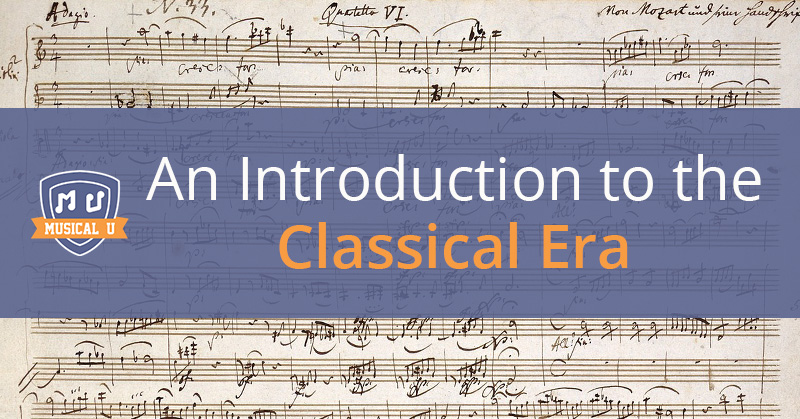When classical music is mentioned, just about everyone has their own idea of what that means. They may be able to recall a certain orchestral piece or list some of the most famous composers of the time. However, they might have more difficulty telling you what “classical” music is or how it differs from other important eras in music history.
Classical music has given the world some of the most recognizable pieces of music that are still listened to and played nearly 200 years after they were written. With such longevity in mind, it’s easy to see why understanding some of the underlying features of classical music might be beneficial to your own growth as a musician.
What is “classical” and when was the classical era?
The Classical era directly followed the Baroque era. From roughly 1750 to 1820, society moved toward a “classical” style of thinking and drew mainly from Greek antiquity. This affected not only music, but literature and architecture as well. In contrast to the inclusion movement of the previous Baroque era, society was more interested in creating order, hierarchy, and simplicity to reflect their view of the world. This lead to a drastically different style of music that we now refer to as “classical music.”
Characteristics of Classical Music
Because of the sudden shift in ideals, classical music is easy to distinguish when compared to other forms of music. Keep an ear out for these determining features of classical music.
Simplicity. When we say classical music is simple, that doesn’t necessarily mean that it’s easy to play. Baroque music was criticized at the time for using too many different composition techniques that made it seem dissonant and incredibly difficult to play. Classical composers streamlined their work to give it continuity and harmony.
Homophony. One of the main ways to simplify musical pieces was to make them homophonic – meaning one major part was supported by one or more smaller strands. This created a much more pleasing soundscape for listeners as opposed to the polyphony that was prevalent in previous musical forms.
Order. Composers created pieces of music that reflected the order and structure they saw in the world. Each piece was very clearly defined and tended to be shorter. This made it easier to include a wider variety of keys, melodies, and dynamics; such as crescendo (playing louder), diminuendo (playing softer), and sforzando (playing with a very loud, surprising emphasis).
Larger Orchestras. Though the harpsichord fell out of popular use, the orchestra itself grew both in size and range. The piano was utilized much more prevalently and the woodwinds became their own section.
Instrumental Music. Classical music was almost entirely without any lyrics or vocalizations. The pieces were generally written as string quartets, symphonies, concertos, and most importantly, as sonatas. Sonatas became one of the most featured forms of music included as part of larger works or independently as overtures.
Style. Classical music was dominated by style galant. This emphasized lighter music that was considered more elegant than those of the heavy, complex Baroque period. It also featured one soloist with accompaniment rather than several competing musicians within a piece.
Famous Classical Composers
Franz Joseph Haydn. One of the first composers to solidly create what we consider classical music, Haydn is known both as the father of the symphony and the string quartet. Though he may not have the name recognition of other classical composers, he wrote over 40 symphonies in the 1760s alone and was a major influence on Western music as a whole.
Wolfgang Amadeus Mozart. An undoubted musical genius, Mozart’s greatest ambition was to bring music to the people. Many composers worked directly for the courts, but Mozart strove to write operas and perform in front of large, public audiences at the international level. Mozart drew inspiration from Haydn but also added a greater range of instruments, dramatic effect, and melodic resonance to his work.
Ludwig van Beethoven. Perhaps the most famous of all classical composers, Beethoven has one of the largest libraries of work despite losing his hearing in the middle of his career. Beethoven was a master of classical instruments, especially the piano. His works grew in complexity as his career extended into the new Romantic era.
Other notable composers from the time include Christoph Willibad Gluck, C.P.E. Bach, Johann Nepomuk Hummel, and Franz Schubert.
Classical music was a microcosm of the world at the time. It reflected a large shift in how people viewed the world and for that reason, resonated deeply with them. Its simplicity in form made it easier to create and perform for the first time. It’s easy to see how music composed more than 200 years ago is still so widely admired today.







